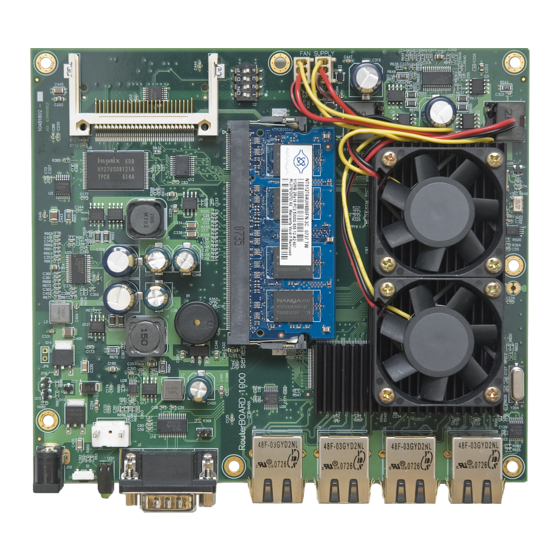Table of Contents
Advertisement
Quick Links
RouterBOARD 1000
Quick Setup Guide and Warranty Information
Assembling the Hardware
First use of the board:
In most cases you do not need to use any additional boot devices, as you can boot the RouterBOARD from the
●
onboard NAND memory. You can also install one or two CompactFlash modules or Microdrive hard drives, which you
can use as an alternative boot device (Not for RouterOS. In J4 slot only) or additional storage media (in any or both
slots);
●
Install the board in a case
●
Connect other peripherals and cables.
Powering
The board accepts powering from the power jack only, 12V is supported.
Booting process
First, RouterBOOT loader is started. It displays some useful information
on the onboard RS232C asynchronous serial port. The serial port is set by
default to 115200bit/s, 8 data bits, 1 stop bit, no parity. Note that the
device does fully implement hardware (RTS/CTS) flow control. The loader
may be configured to boot the system from the onboard NAND, and/or
from network. See the respective section of User's manual on how to
configure booting sequence and other BIOS parameters.
DHCP or BOOTP (configurable in loader) protocols allow the RouterBOARD
1000 series board to get an initial IP address, and provide the address of
a TFTP server to download an ELF boot image from. It is especially useful
for software installation. See the User's manual for more information and
protocol details. Note that you must connect the RouterBOARD you want
to boot and the BOOTP/DHCP and TFTP servers to the same broadcast
domain (i.e., there must not be any routers between them – they must be on the same Ethernet switch).
Extension Slots and Ports
●
Four Gigabit Ethernet ports, supporting automatic cross/straight cable correction (Auto MDI/X), so you can use either
straight or cross-over cables for connecting to other network devices.
DB9 RS232C asynchronous serial port.
●
SODIMM memory slot, populated with 512MB DDR2 667MHz SODIMM memory, supports up to 2Gb RAM modules that
●
match these specifications. Due to a hardware limitation, only 1.5Gb will be used from a 2Gb module.
See
www.routerboard.com
for more information. Contact
support@mikrotik.com
for support questions.
rev. C (11-Jan-2010)
Advertisement
Table of Contents

Summary of Contents for MikroTik RouterBOARD 1000
- Page 1 RouterBOARD 1000 Quick Setup Guide and Warranty Information Assembling the Hardware First use of the board: In most cases you do not need to use any additional boot devices, as you can boot the RouterBOARD from the ● onboard NAND memory. You can also install one or two CompactFlash modules or Microdrive hard drives, which you can use as an alternative boot device (Not for RouterOS.
- Page 2 If you have purchased your product from a MikroTik Reseller, please contact the Reseller company regarding all warranty and repair issues, the following instructions apply ONLY if you purchased your equipment directly from MikroTik Latvia To return failed unit or units to MikroTikls you must perform the following RMA (Return Material Authorization) procedure.
















Need help?
Do you have a question about the RouterBOARD 1000 and is the answer not in the manual?
Questions and answers